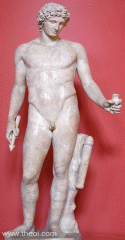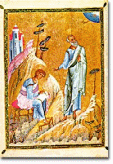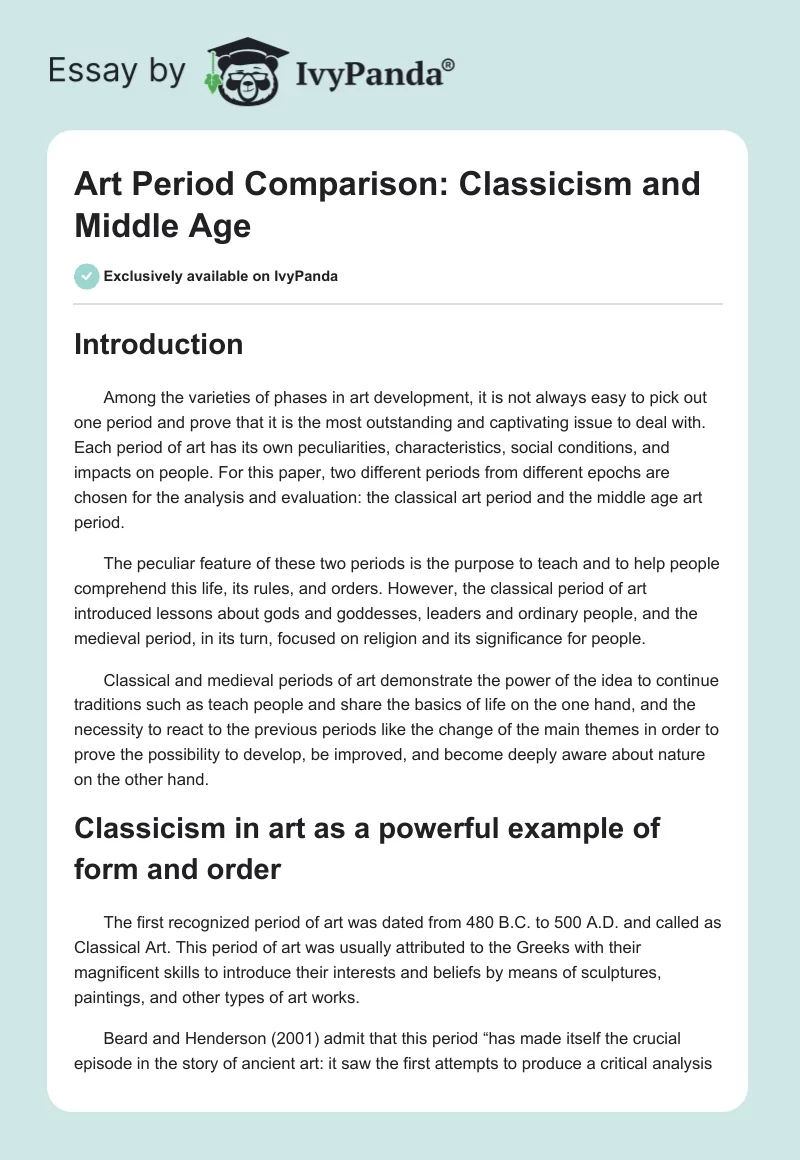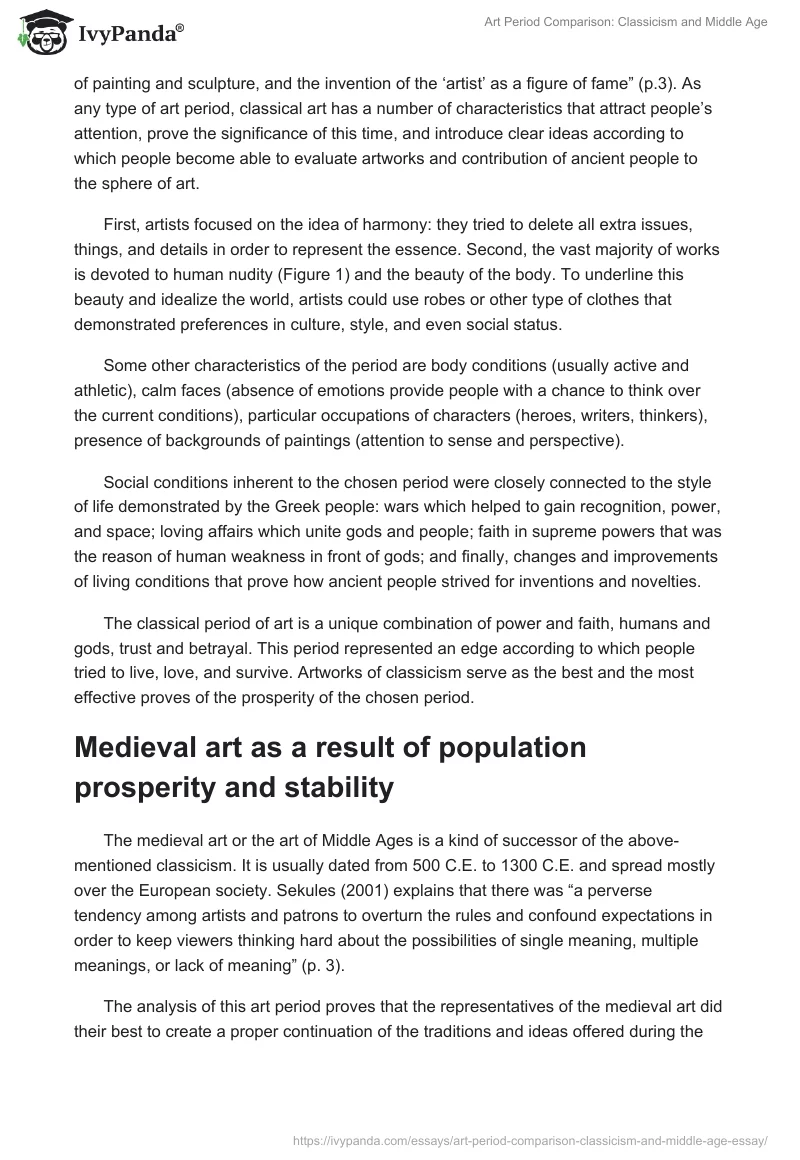Introduction
Among the varieties of phases in art development, it is not always easy to pick out one period and prove that it is the most outstanding and captivating issue to deal with. Each period of art has its own peculiarities, characteristics, social conditions, and impacts on people. For this paper, two different periods from different epochs are chosen for the analysis and evaluation: the classical art period and the middle age art period.
The peculiar feature of these two periods is the purpose to teach and to help people comprehend this life, its rules, and orders. However, the classical period of art introduced lessons about gods and goddesses, leaders and ordinary people, and the medieval period, in its turn, focused on religion and its significance for people.
Classical and medieval periods of art demonstrate the power of the idea to continue traditions such as teach people and share the basics of life on the one hand, and the necessity to react to the previous periods like the change of the main themes in order to prove the possibility to develop, be improved, and become deeply aware about nature on the other hand.
Classicism in art as a powerful example of form and order
The first recognized period of art was dated from 480 B.C. to 500 A.D. and called as Classical Art. This period of art was usually attributed to the Greeks with their magnificent skills to introduce their interests and beliefs by means of sculptures, paintings, and other types of art works.
Beard and Henderson (2001) admit that this period “has made itself the crucial episode in the story of ancient art: it saw the first attempts to produce a critical analysis of painting and sculpture, and the invention of the ‘artist’ as a figure of fame” (p.3). As any type of art period, classical art has a number of characteristics that attract people’s attention, prove the significance of this time, and introduce clear ideas according to which people become able to evaluate artworks and contribution of ancient people to the sphere of art.
First, artists focused on the idea of harmony: they tried to delete all extra issues, things, and details in order to represent the essence. Second, the vast majority of works is devoted to human nudity (Figure 1) and the beauty of the body. To underline this beauty and idealize the world, artists could use robes or other type of clothes that demonstrated preferences in culture, style, and even social status.
Some other characteristics of the period are body conditions (usually active and athletic), calm faces (absence of emotions provide people with a chance to think over the current conditions), particular occupations of characters (heroes, writers, thinkers), presence of backgrounds of paintings (attention to sense and perspective).
Social conditions inherent to the chosen period were closely connected to the style of life demonstrated by the Greek people: wars which helped to gain recognition, power, and space; loving affairs which unite gods and people; faith in supreme powers that was the reason of human weakness in front of gods; and finally, changes and improvements of living conditions that prove how ancient people strived for inventions and novelties.
The classical period of art is a unique combination of power and faith, humans and gods, trust and betrayal. This period represented an edge according to which people tried to live, love, and survive. Artworks of classicism serve as the best and the most effective proves of the prosperity of the chosen period.
Medieval art as a result of population prosperity and stability
The medieval art or the art of Middle Ages is a kind of successor of the above-mentioned classicism. It is usually dated from 500 C.E. to 1300 C.E. and spread mostly over the European society. Sekules (2001) explains that there was “a perverse tendency among artists and patrons to overturn the rules and confound expectations in order to keep viewers thinking hard about the possibilities of single meaning, multiple meanings, or lack of meaning” (p. 3).
The analysis of this art period proves that the representatives of the medieval art did their best to create a proper continuation of the traditions and ideas offered during the classical period. Though a number of distinguished tendencies were inherent to the medieval art, all these differences had powerful grounds and clear explanations.
Among the variety of specific characteristics of the chosen period, it is necessary to define the following: religious nature of all artworks that demonstrated Jesus’ role in society, impact of saints and other characters from the Bible; identification of major and minor characters of paintings (major characters were bigger and brighter); absence of nudity that was so inherent to classical works (Figure 2); bright colors preferred; and faces full of serious emotions and confidence.
To represent a proper continuation of traditions, it is important not only to rely on the achievements and inventions but also to prove that society was able to change and choose other aspect to respect and consider.
The representatives of the medieval art were known as those who preferred warm colors and gold in particular (Figure 2). They truly believed that such attention to colors could make them closer to Jesus and religious they believed in. A great number of medieval artists aimed at teaching people about the ways of how to respect the supreme power, what kind of effect this power may be used on people, and why religion became so crucial for human lives.
Similarities and differences between classicism and medieval art
The idea to keep traditions turns out to be important for the sphere of art during a long period. It is not enough to present a new art approach and define it as a new era of art. This is why it is necessary to continue traditions as well as to reflect on the existed achievements.
The representatives of the medieval art tried to use the same material that was used by the representatives of the classical period to admit that the chosen material was really strong and appropriate for the chosen sphere.
With the help of backgrounds and centralizing of figures (that came from classicism), medieval artists introduced the works and pay more attention to main images by means of decreasing the necessity of the minor characters. Respect to gods (classicism) had much in common with religion (medieval art) because both tendencies demonstrated human dependence on power.
Conclusion
All these differences and similarities of two different periods of art serve as a good example of how people are able to develop, teach, evaluate, and analyze their lives. The idea to use the basics of classicism and improve the medieval works sounds perfect because this is how continuation and creativity should cooperate.
The historical significance of the medieval period of art of the world art in general lies in the fact that people proved how they could use their knowledge and experience in order to create magnificent works, sculptures, and paintings, and teach a future generation how to succeed in development.
Reference List
Beard, M. & Henderson, J. (2001). Classical Art: From Greece to Rome. New York: Oxford University Press.
Sekules, V. (2001). Medieval Art. New York: Oxford University Press.
Appendix
Figure 1: Apollo

Figure 2: The Icon of St. John the Evangelist.



